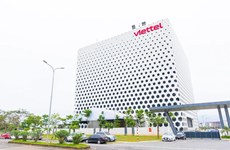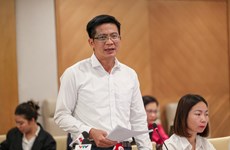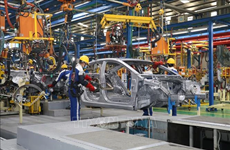Strategy for Science, Technology and Innovation Development until 2030 approved
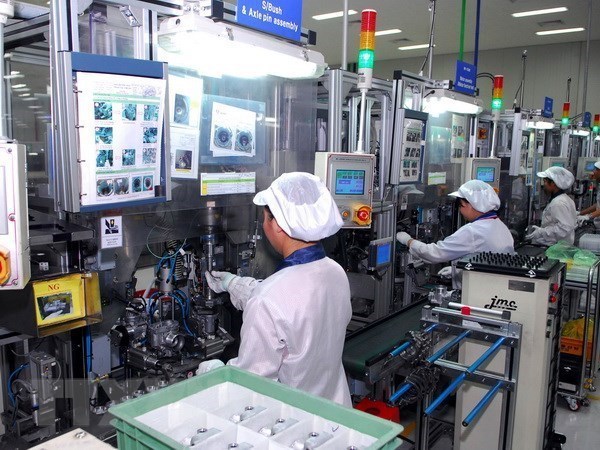 By 2030, the value proportion of high-tech industrial products in Vietnam's processing and manufacturing industry will reach at least 45%.(Photo: VNA)
By 2030, the value proportion of high-tech industrial products in Vietnam's processing and manufacturing industry will reach at least 45%.(Photo: VNA)Hanoi (VNA) - Deputy Prime Minister Vu Duc Dam has signed Decision No. 569/QĐ-TTg dated May 11 issuing a strategy for scientific-technological development and Innovation until 2030.
DECISION
Promulgating the Strategy for Science, Technology and Innovation Development until 2030
THE PRIME MINISTER
Pursuant to the Law on Organisation of the Government dated June 19, 2015; the Law on amendments and supplements to some articles of the Law of Organisation of the Government and the Law on Organisation of the Local Administration dated November 22, 2019;
Pursuant to the Law on Science and Technology dated June 18, 2013;
At the proposal of the Minister of Science and Technology.
DECIDES:
Article 1. Promulgating the Strategy for Science, Technology and Innovation Development until 2030 (hereinafter referred to as “the Strategy”), with the following contents:
I. VIEWPOINTS ON SCIENCE, TECHNOLOGY AND INNOVATION DEVELOPMENT
1. Developing science, technology and innovation is the top national policy and plays a strategic breakthrough role in the new period; is the main motivation to promote growth, create breakthroughs in productivity, quality and efficiency; is the decisive factor in the improvement of the competitiveness of the nation, socio-economic sectors, localities and enterprises; is the stepping stone for the implementation of national digital transformation; and significantly contributes to improving the people's life, promoting sustainable development and safeguarding national defence and security.
2. Developing social sciences and humanities, natural sciences, technical sciences and technology in a concerted, interdisciplinary and focus-driven manner. Developing the national innovation system and regional and sectoral innovation systems, in which enterprises are the centre, research institutes and universities are strong research bodies, and the State issues orientations, coordinates and creates a favourable regulation and policy environment for effective operations of the whole system.
3. Harmoniously and effectively combining the development of internal capacity with the optimisation of opportunities and external resources. Prioritising the acquisition, absorption, mastery and fast application of advanced scientific and technological advances in the world, in particular, proactively and actively approaching and thoroughly capitalising on the opportunities and achievements of the Fourth Industrial Revolution. Promoting applied research that bring about socio-economic benefits while at the same time, paying attention to application-oriented basic research towards inventing, mastering and competing in technology in the key areas that Vietnam has demand, potential and advantages.
II. OBJECTIVES OF SCIENCE, TECHNOLOGY AND INNOVATION DEVELOPMENT
1. Overall objectives
By 2030, science, technology and innovation will be firmly developed, truly become motivation for growth, and make a decisive contribution to the development of Vietnam into a developing country with modern industry and upper-middle income; contribute to the comprehensive development of culture, society and people, the safeguarding of national defence - security, environmental protection, sustainable development and improvement of Vietnam's international stature and reputation. The capacity and level of science, technology and innovation will reach advanced levels in many key areas, making Vietnam one of the best performers among upper-middle-income countries. Enterprises’ technology and innovation level and capacity will surpass the global average. Some areas of science and technology will reach international level.
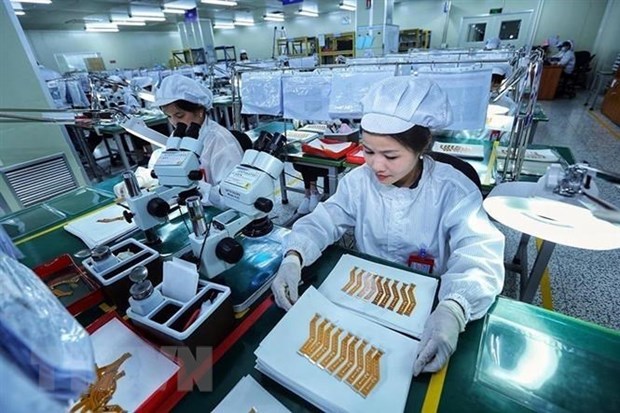 Developing science, technology and innovation plays a strategic role in the new period.(Photo: VNA)
Developing science, technology and innovation plays a strategic role in the new period.(Photo: VNA)2. Specific objectives:
a) Improving science, technology and innovation’s contribution to economic growth via scientific research and technological development by research institutes and universities, technological innovation and enhancement of governance and organisation capacity in enterprises. Total factor productivity (TFP)’s contribution to economic growth will be above 50%.
b) Science, technology and innovation will play an important role in the development of spearhead industries, with the processing and manufacturing industry as a focus, to significantly help with restructuring the economy in a modernity-oriented manner and turning Vietnam into a country with modern industry by 2030. Actively and effectively participating in and making use of trade advantages and opportunities of the Fourth Industrial Revolution. By 2030, the proportion of the value of high-tech industrial products in the processing and manufacturing industries will reach at least 45%.
c) Science, technology and innovation will significantly contribute to the building and development of cultural and social values and people of Vietnam; provide scientific ground for the making of guidelines and policies on national development; and help maintain the Human Development Index (HDI) at over 0.7.
d) The Global Innovation Index (GII) will be improved continuously, among the top 40 in the world.
dd) By 2025, investment in science and technology will reach 1.2% - 1.5% of GDP, of which total national expenditure on scientific research and technological development will be equivalent to 0.8% - 1% of GDP, and the society's contribution to scientific research and technological development will account for 60% - 65%. By 2030, investment in science and technology will reach 1.5% - 2% of GDP, of which total national expenditure on scientific research and technological development will be equivalent to 1% - 1.2% of GDP, and the society’s contribution to scientific research and technological development will make up 65% - 70%.
e) By 2025, human resources for scientific research and technological development (full time) will reach 10 people per ten thousand people, and by 2030, 12 people per ten thousand people. In particular, focus will be put on the development of human resources in enterprises.
g) The system of science and technology organisations will be restructured in line with the orientation of prioritising development of the nation, industries and areas toward self-reliance, connectivity, and approach to international standards. By 2025, 25 - 30 science and technology organisations will be given regional and international rankings, and by 2030, the figure will be 40 - 50.
h) By 2030, the number of enterprises meeting the criteria for science and technology enterprises and the number of innovative start-ups will double the figures in 2020; the rate of businesses with innovation activities will account for 40% of the total.
i) The number of international publications will increase by an annual average of 10%. The number of applications for patent registration and patent protection titles will increase 16% - 18% per year on average; the number of applications for protection of plant varieties will increase by an annual average of 12% - 14%, of which 10% - 12% will be filed abroad; the rate of patents that are commercially exploited will reach 8% - 10% of the total patents granted protection titles. Developing the national quality infrastructure (NQI) that meets the requirements for strong international integration in terms of standards, measurement and quality, among the top 50 in the world.
III. KEY ORIENTATIONS FOR SCIENCE, TECHNOLOGY AND INNOVATION DEVELOPMENT
1. Orientations for focal tasks in the development of science, technology and innovation
a) Science, technology and innovation focus on serving sustainable and inclusive socio-economic development, and national defence and security safeguarding.
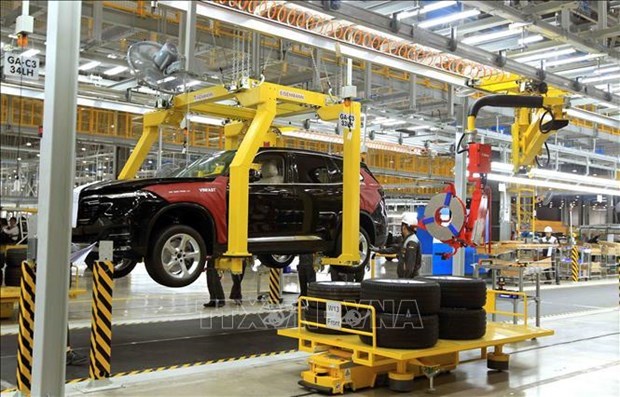 Science, technology and innovation play an important role in developing spearhead industries focusing on processing and manufacturing. (Photo: VNA)
Science, technology and innovation play an important role in developing spearhead industries focusing on processing and manufacturing. (Photo: VNA)Promoting the restructuring of the economy in a way that increases the proportion of the value of hi-tech industrial products, helps sectors gain high productivity and added value by applying advanced and modern technology in tandem with promoting digital transformation in all sectors; promoting the development of processing and manufacturing industries and some spearhead industries and sectors basing on the technological foundation of the Fourth Industrial Revolution; gradually reducing the proportion of industries that have low labour productivity and added value and use outdated technologies.
Acquiring, mastering, transferring and widely applying advanced technologies in the world to improve labour productivity, product and service quality, and competitiveness of enterprises; proactively build solutions and technologies of Vietnam to develop green and circular economy, protect the environment, respond to challenges from disease outbreaks and climate change; researching and applying science and technology to the development of the defence industry in a dual-use and increasingly modern way, thus meeting the requirements of the Fatherland safeguarding in the new context.
Strengthening technological self-reliance and progressing towards the development of new technologies for Vietnam in some key sectors that the country boasts strength, potential and much room. Mastering core technologies, source technologies, and technologies of the Fourth Industrial Revolution in order to quickly absorb and apply them to the development of new products and services, key products and national brands, and carry out digital transformation in enterprises.
b) Reforming and completing the state management of science, technology and innovation
Perfecting the legal system on science, technology and innovation in conformity with the market mechanism and international practices; synchronising the legal regulations and policies related to science, technology and innovation in a way that removes bottlenecks and barriers, and creates the best possible conditions for the development of science, technology and innovation. Increasing breakthrough tools and policies in order to encourage and promote the application of new technology and innovation to improvement of enterprises’ competitiveness.
Improving the national innovation system, regional or sectoral innovation systems, high-tech parks, the innovation centre network, the innovative startup network, and intermediary and supporting organisations helping promote innovation.
Raising the capacity of the state governance over science, technology and innovation, especially the capacity to make and organise the implementation of policies on science, technology and innovation. Promoting and completing the mechanism for power decentralisation in the state management of science, technology and innovation in a way that ensures leanness, efficiency and effectiveness.
c) Developing the potential for science, technology and innovation
Arranging the system of public science and technology organisations in conformity with the priority orientations for science, technology and innovation, socio-economic development of the country, sectors and regions, and in a way that connects research with training.
Focusing on developing domestic human resources and attracting foreign and overseas Vietnamese experts who have high qualifications and creative capacity, in accordance with industrialisation requirements in the new context.
Continuing to effectively invest in and capitalise on hi-tech parks, hi-tech agricultural zones, concentrated information technology parks and laboratories in association with priority research areas; developing and improving the quality of the national science and technology information system towards digital transformation.
d) Promoting science, technology and innovation activities in enterprises and developing the science and technology market
Promoting the development of the science and technology market, gradually increasing the proportion of domestic technology and equipment supply, stepping up intermediary activities of the science and technology market, moving towards integration with commodity, labour and financial markets.
Focusing on promoting the transfer and application of advanced technologies, improving the technology absorption and innovation capacity, corporate governance, qualifications and skills of human resources; implementing digital transformation; reforming production process and business model of enterprises in conformity with the technological innovation process.
Increasing the quantity, quality and efficiency of the utilisation of intellectual assets, attaching importance to the development of enterprises’ intellectual assets and enhancing the protection and exercise of intellectual property rights. Promptly formulating national standards and basic standards for new technologies and products, exports and key products in order to meet the market’s requirements; ensuring that the development of intellectual assets and goods standards and quality is an effective tool for promoting innovation and the application of new technology.
2. Orientations for the development of scientific research
a) Social sciences and humanities
- Researching and predicting development trends in the period to 2030 and the following decades, including trends of globalisation and international integration; trends of competition and conflict in the international context; the formation of new linkages in the world and the region; and sustainable development trend. Researching and predicting impacts of major global and regional trends on Vietnam’s development model, institution and security. Studying policies and solutions for Vietnam to seize opportunities and overcome challenges to develop, safeguard security and raise its stature.
- Continuing to review practices in the national renewal, construction and development to serve the formulation of guidelines, strategies and policies for national development and safeguarding in each period of time; conducting theoretical studies on development in the new context to provide grounds for the identification of a pathway to turn Vietnam into a developing country with modern industry and upper-middle income by 2030 and a high-income developed nation by 2045.
- Studying scientific and practical grounds for renovating the leadership method and improving the leadership capacity, ruling capacity and combat capacity of the Party; reforming state management and national governance, strongly promoting the people’s right to mastery, accelerating public administrative and judicial reforms, building and perfecting the rule-of-law socialist state of Vietnam in accordance to the new situation in each development stage of the country. Exploring ways to renew and improve the roles and responsibilities of organisations within the political system; reforming and strengthening the force of law and socialist legislation; ensuring human rights and citizens’ rights, and maintaining national defence and security.
- Exploring how to perfect the institution of socialist-oriented, full market economy in the new context; properly defining and bringing into full play the roles of all economic sectors, particularly the private one, to create a new engine of growth; forecasting and putting forth recommendations to improve the country’s resilience against internal and external challenges and risks, ensure macro-economic stability, and rapidly, effectively and sustainably develop the country, regions and localities.
- Identifying conditions, solutions and a roadmap for renovating and transforming the economic development model based on science, technology, innovation and digital economy to improve productivity, quality, effectiveness and competitiveness of goods and services as well as the economy as a whole.
- Studying characteristics, structure and development trends of the Vietnamese society in the light of the Fourth Industrial Revolution, international integration and non-traditional security threats; renewing ways of social management in the era of digital transformation; identifying conditions, measures and a roadmap for building a developed Vietnamese society with prosperous people, strong, democratic and civilized country by 2045, as well as a roadmap and specific steps for the next decade.
- Studying the formation, movement and development of cultures, ethnic groups and religions in Vietnam and impacts of new trends in the context of international integration; developing an innovative culture, digital culture and cultural industry serving national growth; building the national great unity bloc and an advanced culture imbued with national identity and embracing the mankind’s cultural quintessence; paying attention to ethnic minority communities, ethnic minority inhabited regions, mountainous areas, vulnerable groups, and regions with extremely difficult natural and socio-economic conditions to ensure the inclusive and harmonious development among residential communities.
- Studying orientations for education and training aimed at developing Vietnamese people in the new era as subjects of the society with comprehensive development, humanity and good cultural values, as well as expertise, skills, creativeness and innovative thinking, thus meeting increasingly high requirements of the country’s industrialisation and modernisation in the context of international integration.
- Studying green innovation policies, with focus placed on environmental, ecological and social aspects in line with the globalisation context.
b) Natural sciences
- Developing an advanced basic science keeping pace with global trends. Stepping up basic research and application-oriented basic research in the fields of Vietnam’s strength and demand to reach regional and global advanced levels, such as mathematics, physics, chemistry, life science, earth science and marine science.
- Studying scientific grounds for the rational use of natural resources; identifying the nature, causes and impacts of natural disasters, nature-human-society interactions and climate change in Vietnam in order to provide scientific evidence for the recommendation and implementation of measures to mitigate and respond to natural disasters, climate change and sea level rise.
- Promoting interdisciplinary studies of natural sciences, social sciences, humanities, and marine technology to provide scientific foundation for the planning, making and perfection of policies in developing, managing and exploiting marine resources, responding to climate change and promoting the sustainable development of marine economy; providing legal bases and historical evidence for defending national sovereignty over Vietnam’s seas and islands; conducting interdisciplinary studies of natural sciences, social sciences and humanities on biodiversity conservation for sustainable development.
- Focusing on application-oriented basic research to acquire and master core technologies and source technologies in order to rapidly, creatively, effectively and widely apply advanced technologies in production, services, business, daily life and social management for higher productivity, quality and competitiveness of enterprises, sectors and the economy as a whole, as well as for improved living standards and guaranteed national defence and security.
 Science, technology and innovation make important contributions to building and developing Vietnamese cultural, social and human values. (Photo: VNA)
Science, technology and innovation make important contributions to building and developing Vietnamese cultural, social and human values. (Photo: VNA)3. Orientations for technology development and application
a) Information and communications technology
- Promoting research and wide application of information and communications technology with focus placed on cloud computing, internet of things, artificial intelligence, blockchain and virtual reality, along with the building and formation of big data as the core factor to boost digital transformation, develop digital economy, digital government and digital society, and create smart products, equipment and utilities applicable in production, services, business, social management and daily life. Mastering information safety and cyber security to ensure national security and sovereignty, interests of people and organisations, and effectively preventing cyber-attacks.
- Transferring technology and raise capacity in mastering, absorbing and promoting scientific research and technology development towards the invention of technologies for designing and manufacturing devices for telecom and mobile networks, 5G terminals and next-generation devices.
- Studying and mastering quantum and terahertz technologies.
b) Biotechnology
- With regard to health care and disease diagnosis and treatment, focusing on studying the application of gene and stem cell technologies to treat life-threatening diseases; researching and producing diagnostic biological products, vaccines and drugs for the prompt prevention and control of emerging and re-emerging human diseases; researching and developing herbal plants, producing drugs and health food meeting food safety requirements.
- In agriculture, focusing on biotechnology to create high-yield, high-quality and high-value-added crop, livestock and aquatic varieties resilient to ecological conditions and climate change impacts in Vietnam; developing biotechnology for the control and treatment of environment pollution in horticulture, husbandry and aquaculture; manufacturing vaccines, pharmaceuticals, veterinary drugs, diagnostic biologicals and those for production of animal feed, bio-pesticides, functional and microbial organic fertilisers.
- In the processing industry, focusing on research and development of biological products for food processing in an attempt to raise the added value of agricultural commodities; mastering technologies and manufacturing a comprehensive set of equipment in the bio-industry.
- With regard to environment protection, focusing on collecting and recycling by-products, treating environment pollution by biotechnology; preserving, storing and properly using rare genetic resources; and protecting biodiversity.
c) New material technology
- Transferring technology, researching and manufacturing new advanced materials for industry and construction such as functional materials with modified physical and mechanical properties, advanced polymers and composites, metal and alloy materials, protective coatings against extreme conditions, advanced technical ceramics, smart materials, new materials that are absorbent or transparent to electromagnetic waves, 3D printing materials, chemicals and materials for mechanical engineering, supporting industry and petrochemicals, recycled materials used in construction of traffic works; advanced materials for agriculture such as controlled-release fertilisers, biological pesticides, smart packaging, greenhouse materials, sensor materials for greenhouses, materials improving soil and artificial soil; biomedical materials such as implant materials, targeted drug carriers, biodegradable materials, smart composites capable of promoting cartilage and bone regeneration; biodegradable materials helping reduce environmental pollution such as biodegradable materials to replace plastics, biodegradable films; advanced materials for national defence and security such as ultra-durable, high-temperature and high-pressure resistant materials, materials for control systems; alloys with special features; electronic and photonic materials in modules and equipment of telecommunications, electrical engineering and energy-saving systems, especially optical fiber materials.
 Developing science, technology and innovation is an important task (Photo: VNA)
Developing science, technology and innovation is an important task (Photo: VNA)- Researching and mastering technologies of energy storage and conversion materials such as batteries, high-performance fuel cells, hydrogen storage materials, photoelectric, thermoelectric, photothermal conversion materials, wind power materials, and biofuel.
d) Technology of machine manufacturing and automation
- Acquiring, mastering and developing advanced and smart manufacturing-automation technologies, including technology of designing and manufacturing synchronised equipment and production lines in petroleum, hydroelectricity and thermoelectricity, shipbuilding, mineral exploitation and processing; technology of manufacturing energy-saving equipment systems; technology for manufacturing complex, large-scale and highly reliable systems; advanced 3D printing, reverse engineering and rapid prototyping technology used in manufacturing all kinds of industrial equipment, electric equipment, metal products and high-grade composites; Automation technology for processing and measuring information, automatic control of production processes; technology for manufacturing microcontroller chips, important high-power semiconductor components used in automation devices; technology of manufacturing basic auxiliary equipment in automation, robot technology, and automatic production lines.
- Researching and manufacturing some new equipment combinations with high accuracy and integration and automation in national defence and security.
 Researching, applying and mastering advanced technology in the management and exploitation of seas, islands and oceans in service of marine economic planning and development (Photo: VNA)
Researching, applying and mastering advanced technology in the management and exploitation of seas, islands and oceans in service of marine economic planning and development (Photo: VNA)dd) Marine technology
Researching, applying and mastering advanced technology in the management and exploitation of seas, islands and oceans in service of marine economic planning and development; advanced technology in searching and exploring resources and minerals, effectively and rationally exploiting marine resources in Vietnam's waters and coastal areas on the basis of green growth, marine biodiversity and marine ecosystem conservation, ensuring harmony between conservation and development, maintaining marine natural capital; advanced technology in warning and forecasting natural disasters and marine environmental incidents, responding to climate change in the waters and coastal areas of Vietnam.
e) Technology in natural disaster prevention and climate change response
Researching, applying, and mastering technology in forecasting impacts of climate change on natural and social systems, technology in reducing greenhouse gas emissions, technology in identifying, forecasting and warning types of natural disasters, especially dangerous ones in high-risk areas.
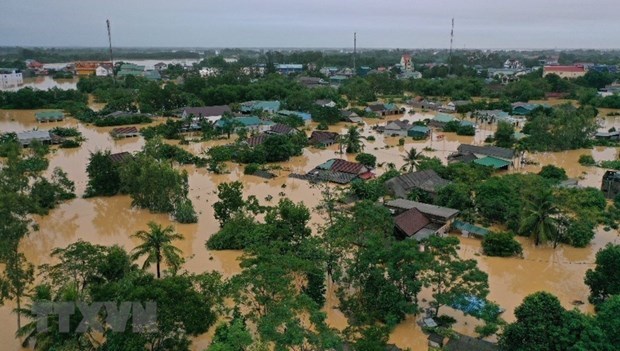 Technology research and application to serve natural disaster prevention and response to climate change (Photo: VNA)
Technology research and application to serve natural disaster prevention and response to climate change (Photo: VNA)g) Energy technology
- Researching, applying, and mastering new energy, renewable energy and smart energy technologies, advanced energy storage technology, fuel cell. Developing and applying advanced technologies in underground coal mining, oil and gas exploitation technology in deep water and offshore areas, and liquefied natural gas (LNG) thermal power technology.
- Researching and applying atomic energy, nuclear and radiological technology in socio-economic sectors and fields; solutions to ensure radiation safety and nuclear safety, especially in healthcare, agriculture, industry and the environment.
h) Environmental technology
Promoting the application and mastering of clean production technology, environmentally friendly technology, wastewater, solid waste, hazardous waste and exhaust gas treatment technology, waste recycling technology with features and prices suitable for the conditions of Vietnam. Developing, applying and transferring advanced technology and modern equipment for waste recycling, sustainable use of resources and environmental restoration; carbon capture and storage technology in thermal power plants and other carbon-emitting production facilities.
i) Space technology
- Focused and targeted investment in several space technology fields, promoting the exploration, exploitation and use of outer space for peaceful purposes, including earth science, earth observation and supervision; space science; exploration systems; space activities and related fields.
- Strengthening the capacity of managing natural resources and the environment, supervising and assisting in reducing damage caused by natural disasters, ensuring national defence and security, and providing diverse services to the people.
- Researching, acquiring and mastering techniques and technology in designing and manufacturing a number of important equipment used in small satellites, earth stations, and terminals.
k) Advanced and smart construction, transportation and infrastructure technology
Mastering advanced techniques for foundation and erosion treatment. Researching, acquiring and mastering techniques and advanced technologies in the design and construction of infrastructure, transportation, irrigation and smart cities.
4. Orientation of innovation activities
a) Innovation in agriculture
Promoting big enterprises to invest in breeding technology, care and monitoring technology in accordance with safety and traceability standards, preservation technology, and processing technology; focusing on investment in hi-tech agricultural zones, large-scale projects, the implementation of advanced and effective cultivation models in accordance with international standards; developing new techniques for business into small and medium-sized enterprises in agriculture, forestry and fisheries.
Focusing on mastering important technology combinations for breeding through self-research, development as well as exploitation of seed banks, purchase of seeds from foreign countries in order to decipher and master the technology. Focusing on the application of biotechnology, information and communication technology and automation technology to build a smart, safe, circular, efficient and sustainable agriculture, promoting the advantages of a tropical agriculture.
Forming agricultural innovation systems associated with agricultural economic models, production chains, value chains and products with high economic values, actively contributing to linkages between the development of agriculture, the building of new-style rural areas and the improvement of the mental and physical lives of farmers.
b) Innovation in industry, construction and transportation
Implementing the restructuring process with the orientation of taking science, technology and innovation one of the breakthrough solutions, especially in the context of the Fourth Industrial Revolution. Continuing to attract big-sized enterprises’ investment in innovation, absorption and mastery of technologies, particularly smart production and manufacturing technology, innovation of management and business models, and innovation of products, which serve as the core and help create linkages and networks for promoting innovation in small- and medium-sized enterprises.
Facilitating innovation of lines, equipment, machinery and technologies, providing training in technology governance and exploitation capacity, along with applying new business models and innovation models that have been proved successful to small- and medium-sized enterprises.
Forming innovation systems associated with industrial clusters, domestic and global value chains in industries with big revenues and high export value such as textile-garment, leather-footwear, electronics, equipment and machinery, timber processing, agricultural product processing, mining, and pharmaceuticals, so as to improve productivity, quality and competitiveness of Vietnamese products, services and brands.
Focusing on promoting innovation in platform and spearhead industries such as energy industry, mechanical engineering, metallurgy, chemicals, fertilisers, materials, information and communications technology, electronics-telecommunications industry, robotics and automobile manufacturing industry, integrated equipment for automatic operation, remote control, and software industry.
c) Innovation in the service sector
Applying widely and intensively technology platforms of the Fourth Industrial Revolution and new business models in services, business and public service activities. Building standards, legal frameworks, mechanisms and policies for facilitating the development of digital platform-based enterprises and those applying digital technologies and services.
Supporting training in technology management and governance, updating new technology, and consulting the selection of appropriate technology, supporting training in operation and application of technology in production and business activities. Assisting enterprises in connection and shared use of infrastructure facilities and sharing of data to optimise technology platform-based business models.
d) Innovation in regions
Promoting innovation activities in key regions based on their respective advantages, in which the Red River Delta and southeastern regions are linked to industrial and hi-tech industrial parks; the northern midland and mountainous region is associated with clean agricultural products and tourism; the north central and central coastal region is associated with agriculture and sea-based economy; the Central Highlands region is associated with agro-forestry products, processing of agro-forestry products, and tourism; and the Mekong Delta region is associated with agricultural production, development of agricultural product processing, seed centres and technology transfer. Intensifying research into cultures, religions and humans, and solutions in response to climate change associated with characteristics of regions and localities.
Setting up an innovation system associated with value chains, sectoral connectivity clusters, and innovative start-up ecosystems in regions and localities which have adequate necessary conditions in terms of human resources for innovation, training institutions, research institutes, and material and technical facilities in association with economic advantages of regions and localities.
IV. MAJOR TASKS, SOLUTIONS FOR SCIENCE, TECHNOLOGY AND INNOVATION DEVELOPMENT
1. Reforming science, technology and innovation mechanisms, and improving the State management of science, technology and innovation
a) Amending and perfecting the legal system on science and technology, and relevant laws to satisfy new requirements set for science, technology and innovation development, and promoting innovation in tandem with science and technology; forming a legal framework for the implementation of pilot, experimental and specific mechanisms for new economic types/models based on science, technology and innovation. Studying the reform of mechanisms, policies and laws on investment, public investment, public procurement, state budget, public assets and tax to encourage and develop science, technology and innovation activities. Perfecting laws on intellectual property, protecting and effectively and rationally utilising intellectual assets created by Vietnam.
b) Comprehensively reforming management activities, implementing science and technology tasks at all levels towards publicity, transparency and objectivity, and simplifying administrative procedures; conducting digital transformation in management processes and database of science, technology and innovation resources; reforming the finance and payment management mechanisms, accepting the principle of risk and delay in science and technology activities; creating favourable conditions for enterprises to engage in the implementation of science and technology tasks; reviewing and amending regulations on the management of science and technology tasks in the direction of removing difficulties and obstacles in the transfer of assets formed in science and technology tasks using state capital.
c) Restructuring science and technology programmes and tasks towards forming product value chains and creating added value. Focusing on developing national products based on new and high technologies to form new industries and new products with high added value, especially in areas of Vietnam’s strength like agriculture, manufacturing and processing, services, information technology, etc. Forming a number of large-scale national science and technology projects and programmes in certain key fields in which Vietnam has strength and potential in order to address especially important long-term problems for national development.
d) Reaching consensus on State management of science, technology and innovation, accelerating innovation in combination with science and technology, raising the efficiency of harmonious coordination in the building and enforcement of mechanisms and policies promoting science, technology and innovation; streamlining the apparatus, focusing on the making of mechanisms, policies and strategic orientations, planning and training plans for science, technology and innovation managers at all levels.
dd) Developing a science and technology forecasting system, building technological development orientations, technology maps and technological reform roadmaps of a number of priority fields, with focus placed on such fields as health care, artificial intelligence, new materials, energy storage and some spheres associated with investment of large enterprises.
e) Measuring and evaluating the efficiency of science, technology and innovation activities conducted by research institutes, universities and enterprises in line with international standards. Sectors and localities integrate science, technology and innovation development targets, including the rate of enterprises with innovation activities, into their development strategies, plans and planning schemes.
2. Building national innovation system
a) Developing a national innovation ecosystem in close association with the region and the world. Developing innovation ecosystems in industry, agriculture and service sectors linked with domestic and global value chains, and sectoral connectivity clusters, in which big enterprises play the central role and lead innovation activities, and State management agencies create a favourable regulation and policy environment to promote linkages between enterprises, research institutes, universities and supporting organisations in research, application and innovation.
b) Developing a system of national innovation centres, innovation centres of sectors and regions and innovative start-up support centres in order to develop and link innovation clusters with hi-tech parks, residential areas, financial centres, venture capital funds, universities and research institutes.
c) Strongly rolling out open innovation platforms and open innovation networks to attract all domestic and foreign investment resources to create new technologies and products, and form new businesses.
d) Increasing linkages among innovation networks, innovative startup networks, innovation centres and scientific research and technological development centres at home and abroad.
dd) Perfecting the organisational system, functions and tasks of, and increasing investment in human resources, finance and infrastructure for public non-business units under the Departments of Science and Technology that perform functions and tasks regarding application and transfer of science and technology and innovation, so that they can become focal points supporting and promoting technology transfer and innovation activities in localities.
3. Attracting and effectively using all investment resources for science, technology and innovation.
a) Ensuring that spending on science, technology and innovation accounts for at least 2% of the total annual state budget expenditure, and gradually increases to meet development requirements of science and technology. Ensuring that expenditures are for right purposes for science, technology and innovation activities.
b) Reviewing and removing barriers and limitations in order to increase the number and scale of science and technology development funds of enterprises; creating the best possible conditions for enterprises to establish investment funds and effectively use them for science, technology and innovation activities; ensuring a law-specified rate of investment set aside for technology development investment funds by state enterprises.
c) Perfecting the public-private partnership mechanism and legal corridors for angel investments, venture capital funds, community investment funds, and digital technology platforms that call for investments, in order to increase investment resources for science, technology and innovation.
4. Developing research institutes, universities and other science and technology organisations into major research subjects
a) Amending and perfecting legal regulations on the autonomy mechanism applicable to public science and technology organisations. Considering the allocation of investment capital to public science and technology organisations based on periodic evaluation of their operational results and efficiency, in association with application of a model under which the State places orders and holds bidding for the implementation of science and technology tasks and the mechanism for setting a package amount to the ultimate product based on outputs; vesting public science and technology organisations with the right to autonomy and accountability for devising their organisational apparatus, recruiting and employing personnel, using budget funds, and performing science and technology tasks.
b) Downsizing the organisational system of public research institutes. Focusing on building a number of research institutes in economic sectors and regions into applied research and innovation centres in service of techno-economic development priorities of economic sectors and regions. Accelerating the merger and transformation into enterprises or equitisation of research institutes that no longer satisfy the conditions on investment priority. Developing and implementing a scheme on transfer of a number of public research institutes engaged in basic research to universities and academies in order to promote the research and training linkage. Improving the capacity of policy research organisations of sectors and localities.
c) Implementing policies and solutions for universities to truly become scientific research and technological development centres, and a source of knowledge for innovation activities. Developing strong research groups and a number of international-level research groups; graduate and postgraduate students are an important force in scientific research and technological development; linking postgraduate training with research topics and projects; encouraging and supporting the establishment of research centres and the transfer of intellectual assets. Studying a mechanism that allows researchers and lecturers to participate in the establishment of innovative start-up businesses from scientific research and technological development results. Building Vietnam National University, Hanoi and Vietnam National University, Ho Chi Minh City and a number of technology universities into nucleus, core and leading institutions of the Vietnamese educational system, which will reach the advanced level and be among the top group in Asia in high-quality human resources training, scientific research and innovation. Turning regional universities into centres of human resources training, research and knowledge transfer serving innovation in regions and localities.
d) Concentrating on developing a number of science and technology organisations of international and regional standards. Evaluating and announcing the rankings and selection of potential science and technology organisations for intensive development investment, and adopting priority mechanisms and policies for placing orders and assigning scientific and technological tasks. Building the Vietnam Academy of Science and Technology and the Vietnam Academy of Social Sciences into the foundations and pillars of Vietnam's science and technology. Encouraging investment in the form of public-private partnership with large enterprises and foreign partners in order to develop outstanding technology centres in universities and research institutes; attracting multinational corporations to establish scientific research and technological development facilities and international innovation centres in Vietnam.
5. Developing science, technology and innovation human resources with high qualifications and creative capacity
a) Preparing science, technology and innovation human resources in the future. Stepping up training in science and technology and improving computer and foreign language skills, and creative design capacity associated with practical projects at high schools, especially through STEM (science, technology, engineering and mathematics) and STEAM (science, technology, engineering, arts and mathematics). Providing more career orientations and consultations on science, engineering and technical disciplines in high schools and universities.
b) Building highly qualified scientific and technological human resources; promptly building a contingent of leading scientists, step by step raising standards of leading scientists approaching those in developed countries. Continuing to implement the programme on selection and sending of trainees to training courses for highly-qualified scientific and technological human resources in priority and key fields in countries with advanced science and technology. Designing mechanisms to encourage and support domestic universities to collaborate with foreign universities in training scientific and technological human resources in Vietnam; and policies on personal income tax incentives for scientific and technological personnel engaged in performing national scientific and technological tasks.
c) Applying solutions to increase the quantity and quality of science, technology and innovation human resources to meet the needs of enterprises. Renovating training programmes for scientific and technological human resources in colleges and universities to meet requirements of the labour market. Creating channels for connection between training institutions and businesses to grasp enterprises’ demands for scientific research, technological development and innovation human resources. Setting up a mechanism for encouraging engineering and technology enterprises to receive university students as interns. Diversifying forms and materials of personnel training for enterprises through digital technology, social media and communication channels. Issuing handbooks on technology management and organising training programmes for enterprises.
d) Encouraging and supporting enterprises to develop human resources for technology management and corporate governance. Intensifying the mobilisation of social resources and diversifying training programmes for technology management and corporate governance personnel of enterprises at different levels. Including knowledge on management and economics, innovation, startup activities, intellectual property, standards, measurement and quality, and productivity in curricula of colleges, vocational schools and universities. Increasing spending on human resources development from science and technology funds of enterprises and providing credit incentives for human resources training.
dd) Promoting the attraction and shift of science, technology and innovation personnel on the basis of reviewing and revising relevant regulations so as to encourage two-way personnel shifts between the public and private sectors; adopting mechanisms and policies on funding and facilitating entry/exit, visa, work permit procedures to attract highly-qualified human resources from abroad and overseas Vietnamese to participate in science, technology and innovation activities in the country; developing networks connecting Vietnamese talents and attracting the participation and contribution of overseas Vietnamese scientists; designing policies to introduce Vietnamese people to work at multinational groups and startups abroad and then return to the country to work; smoothing policies to enable lecturers and researchers to regularly engage in science, technology and innovation activities at enterprises.
6. Developing and efficiently using science, technology and innovation infrastructure
a) Vigorously developing hi-tech parks, hi-tech agricultural zones and concentrated information technology areas. Reviewing and evaluating for improving relevant regulations toward consistency between the Law on High Technology and specialised laws with provisions related to specific mechanisms in infrastructure investment and human resources development in hi-tech parks, hi-tech agricultural zones and concentrated information technology areas. Fostering linkages and coordination between hi-tech parks and hi-tech agricultural zones with concentrated information technology areas and incubators, co-working spaces, business promotion organizations, key and specialized laboratories as well as with infrastructure development and living ecosystems.
b) Developing a system of key laboratories; evaluating and accrediting laboratories of institutes, universities, schools and enterprises as a basis for prioritising the allocation of resources to major research groups and talented scientists and technologists. Increasing state budget funds for the maintenance and warranty of equipment and machinery and for training technical staff to operate state-invested laboratories. Promulgating mechanisms and policies that enable state-invested laboratories to provide services for offsetting costs and reinvesting in regular upgrading activities; permitting institutes, schools and enterprises to use, and pay for state-invested laboratories.
c) Developing a system of international-level domestic science and technology journals. Making adequate investment in the system of domestic journals on the basis of ensuring a balance between different fields of science and technology and types of readers, and encouraging the application of digital technology and association with reputable publishing houses and magazines around the world. Improving qualifications of editors and increase the international diversity of editorial boards; attracting and encouraging scientists at home and abroad to publish high-quality articles on domestic journals. Issuing regulations compelling state budget-funded theses to be published on domestic journals.
d) Deploying the national quality infrastructure (NQI) uniformly from the central to local level, which are synchronous, modern and linked with the Fourth Industrial Revolution, meet requirements of the international integration process and help improve productivity based on science, technology and innovation. Developing the NQI index in the system of statistical indicators of the science and technology sector.
dd) Continuing to improve the capacity of the national information system on science, technology and innovation. Perfecting the national database on science, technology and innovation on the basis of developing and operating interconnected digital platforms, strengthening effective connectivity between scientific and technological information centres of ministries, sectors, localities, universities and research institutes; continuing to purchase a number of valuable core science and technology databases in the world that are of practical significance to domestic research activities. Promoting investment in and development of big data centres on science, technology and innovation and shared scientific data warehouses; connecting open science communities in Vietnam so as to share, criticize and build open data groups and open applications of Vietnam. Completing and enhancing the statistical management of science and technology.
7. Promoting science, technology and innovation activities in enterprises
a) The State shall assist enterprises in improving their access to domestic and international technology information. Developing and providing tools and services for analysing patent information and forecasting technology development trends with a view to setting orientations for science, technology and innovation activities. Building state-invested centres offering science, technology and innovation services as well as consultancy and brokerage services on technology or through providing assistance, strengthening the linkage between private counseling centres and enterprises.
b) Reviewing and amending regulations on tax, finance and credit to make them consistent with those on science and technology so as to effectively implement incentive mechanisms for enterprises which invest in scientific research and technological innovation. Shortening the period of depreciation of machinery and equipment for scientific research and technological development activities. Formulating and implementing an annual tax incentive mechanism for enterprises based on their actual turnover from activities on the list of science, technology and innovation activities. Designing a mechanism for crediting income tax for individuals and enterprises that make donations for science, technology and innovation activities of research institutes and universities.
c) Speeding up the formation and development of scientific research and technological development divisions in enterprises. Facilitating the development of a number of domestic enterprises reaching the region’s leading technological level. Reviewing, adjusting and perfecting the legal corridor that allows the use of scientific and technological outcomes/intellectual assets as capital contribution to establish enterprises.
d) Promoting the transfer of knowledge and training of science, technology and innovation personnel through foreign direct investment (FDI) enterprises. Reviewing and improving incentive policies for FDI enterprises employing highly qualified Vietnamese employees and carrying out scientific research and technological development activities in Vietnam in order to achieve the goal of pervasive technology application. Adopting policies to encourage domestic enterprises to enter into joint ventures with FDI enterprises. Establishing research institutes next to FDI enterprises to learn experience from the latter.
dd) Concentrating on implementing solutions to develop the science and technology market and solutions to increase outlets for products of enterprises. Continuing to improve the competitive environment in trade, raising standards for goods sold and services provided in the country, supporting the wide implementation of intellectual asset management tools and methods, promptly issuing new standards for new technologies and reforming technical barrier to trade (TBT) support activities so as to promote science, technology and innovation in production and business activities. Considering and proposing amendments to policies on public procurement to promote the use of products and services which are outcomes of scientific research and technological development activities in the country. Continuing to support, develop and promote digital transformation in the system of intermediary organisations providing search, evaluation, valuation, brokerage, testing and technology transfer services. Connecting technology exchanges with centres for application and transfer of scientific and technological advances in localities in order to form a unified and comprehensive network to provide the best support for technology innovation activities of enterprises. Reviewing, evaluating and perfecting policies on technology import (tax incentives, credit, support, etc.) to intensify the transfer of advanced technologies from abroad.
e) Continuing to review, adjust and implement mechanisms and policies to strongly develop science and technology enterprises, hi-tech enterprises and innovative startups. Encouraging businesses to invest in research and application of hi-tech, new-technology and digital transformation solutions developed by domestic enterprises instead of imported ones.
g) Increasing assistance for the operation of business associations in order to promote linkage of science, technology and innovation activities among enterprises. Building a network of consultants directly providing enterprises with consultancy on technology management and corporate governance through associations.
8. Proactively promoting international cooperation and integration on science, technology and innovation
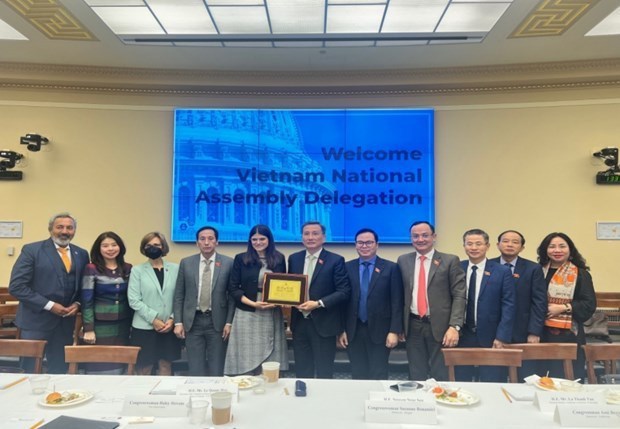 Promoting cooperation between the Vietnamese and US parliaments in science and technology (Photo: VNA)
Promoting cooperation between the Vietnamese and US parliaments in science and technology (Photo: VNA)a) Strengthening international cooperation in scientific research, technological development and application, trading in and transfer of scientific and technological products, implementation of innovative models and solutions, protection and development of intellectual assets, and assurance of goods standards and quality. Promoting inclusion of contents on capacity building and technology transfer in international agreements and treaties to which Vietnam is a party.
b) Actively expanding international cooperation toward supporting a number of science and technology fields in order to bring them to international level. Fostering international cooperation for learning and transferring advanced management models on science, technology and innovation so as to improve the capacity of management apparatuses at all levels.
c) Proactively making effective contributions to the formulation of international frameworks and laws on science, technology and innovation. Actively joining in international research alliances on emerging issues such as COVID-19 vaccines, climate change, etc. The State shall facilitate the participation of enterprises in international research alliances (introducing and providing guarantee for Vietnamese enterprises to engage in research and acquire transferred technologies, etc.).
9. Increasing honouring and communication activities to raise awareness of science, technology and innovation
a) Continuing to maintain and develop national research awards for researchers with outstanding achievements. Designing more awards for innovation activities and enterprises with innovation activities.
b) Encouraging and supporting the youth to improve their science and technology knowledge and provide them with career orientations in the field of science and technology. Investing in establishing a number of television channels, publications and social media channels on science, technology and innovation, particularly those for children and teenagers. Expanding, improving quality of, intensifying communications, and promoting social investment in science, technology and innovation contests and playgrounds for children and teenagers.
c) Continuing to step up communication campaigns about science, technology and innovation. Diversifying types of communication on digital platforms and social media; requiring outcomes of scientific and technological tasks funded by the state budget to be widely disseminated in the mass media. Promoting communications about enterprises with production and business turnover generated from outcomes of scientific and technological activities in order to increase their brand value, win trust of consumers and improve competitiveness of science and technology enterprises and hi-tech enterprises. Strengthening communications about and increasing the State’s support for initiatives on technical improvements by the people. Developing forms of science, technology and innovation displays and museums that can serve a wide range of visitors across the country.
Article 2. Organisation of implementation
1. The Ministry of Science and Technology
a) Assuming the prime responsibility for devising an action plan implementing the Strategy of the science and technology sector; hastening related ministries and sectors and provincial-level People’s Committees to carry out this Strategy and annually report implementation results to the Prime Minister; and organising a preliminary review of implementation of the Strategy nationwide by the end of 2025 and a final review by the end of 2030.
b) Organising the formulation and implementation of five-year and annual science, technology and innovation plans in line with the socio-economic development strategy and plan; national science and technology programmes and projects, innovation-oriented basic research programmes, innovation-oriented research programmes associated with enterprises and the science and technology market.
c) Proposing State budget allocation structure for science, technology and innovation as a basis for developing annual budget plans.
d) Assuming the prime responsibility for and coordinating with relevant ministries and sectors to review and propose relevant agencies build, amend and supplement for promulgating mechanisms and policies within its authority; or submit to authorised agencies for the issuance of mechanisms and polices, especially inter-sectoral coordination mechanisms and preferential policies to encourage science, technology and innovation development.
dd) Assuming the prime responsibility for and coordinating with relevant ministries and sectors to review and propose relevant agencies adjust and build a system of synchronous mechanisms and policies in order to promote innovation activities associated with science and technology.
e) Assuming the prime responsibility for the development of a project to submit to the Prime Minister for decision on establishing a national council on science, technology and innovation in order to promote coordination among agencies in developing science, technology and innovation policies; improve operational efficiency among ministries, sectors in the development and application of science, technology and innovation results in socio-economic development.
2. The Ministry of Planning and Investment
a) Allocating resources for the implementation of objectives and orientations for science and technology development and innovation of the Strategy in the socio-economic development plans of the country, sectors and localities.
b) Assuming the prime responsibility for and coordinating with the Ministry of Science and Technology, and other relevant ministries and sectors to attract investments from businesses and foreign investment funds in science, technology and innovation activities in Vietnam; carry out support programmes to improve technology management and creative capacity for small- and medium-sized enterprises.
c) Prioritising resources for key projects on science, technology and innovation development; research institutes; universities and international standard laboratories; and national, regional and local innovation centres.
 The design of the National Innovation Center in Hoa Lac (Photo: VNA)
The design of the National Innovation Center in Hoa Lac (Photo: VNA)d) Promulgating mechanisms and policies within its authority; formulating and submitting to authorised agencies for the issuance of mechanisms and policies on investment to create motivation for science, technology and innovation activities; and science, technology and innovation application serving socio-economic development.
3) The Ministry of Finance
a) Balancing annual State budget for science, technology and innovation activities in accordance with legal provisions; ensuring the annual plan to facilitate and improve the efficiency of science, technology and innovation activities.
b) Promulgating mechanisms and policies within its authority; and formulating and submitting to authorised agencies for the issuance of mechanisms and policies on finance to create motivation for science, technology and innovation activities; and science, technology and innovation application serving socio-economic development.
4. The Ministry of Education and Training
Assuming the prime responsibility for and coordinating with the Ministry of Science and Technology and relevant ministries and sectors to carry out training activities on science, technology and innovation; STEM and STEAM training in high schools; train and attract science, technology and innovation human resources in universities; and develop universities into strong research centres.
5. The Ministry of Labour, Invalids and Social Affairs
Assuming the prime responsibility for and coordinating with the Ministry of Science and Technology and relevant ministries and sectors to carry out training activities on science, technology and innovation in vocational schools.
6. The Ministry of Home Affairs
Promulgating mechanisms and policies within its authority; and developing and submitting to authorised agencies for the issuance of mechanisms and policies on organisation and personnel to create motivation for science, technology and innovation activities.
7. The Ministry of Information and Communications
a) Assuming the prime responsibility for and coordinating with the Ministry of Science and Technology and relevant ministries and sectors to promote the effectiveness of mass media and new media in order to create favourable conditions for people and businesses to access scientific, technological and innovative products and services.
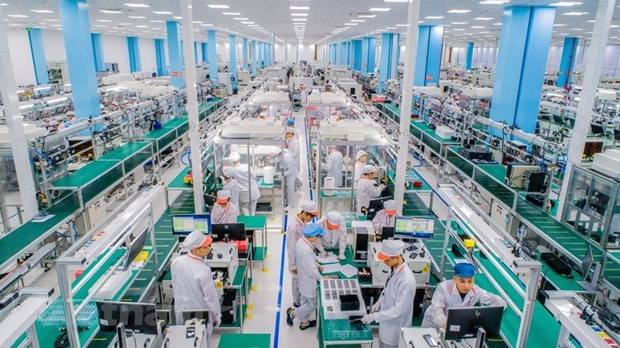 Illustrative image (Photo: VNA)
Illustrative image (Photo: VNA)b) Assuming the prime responsibility for and coordinating with the Ministry of Science and Technology to develop information technology and communication platforms and solutions serving the development of science, technology and innovation.
8. The Ministry of Foreign Affairs
Coordinating with the Ministry of Science and Technology, and relevant ministries and sectors to promote international cooperation in science, technology and innovation; attract and mobilise high qualified human resources from abroad and overseas Vietnamese to participate in science, technology and innovation activities in Vietnam.
9. Ministries, ministerial-level agencies, agencies of the Government, People's Committees of provinces and centrally-run cities
a) Concretising and organising the implementation of objectives, orientations, tasks and solutions in the Strategy for Science, Technology and Innovation Development until 2030 in five-year and annual development strategies and plans of sectors and localities.
b) Directly organising the implementation of strategic goals, tasks and solutions in the state management fields of ministries, sectors and localities.
c) Annually reporting on the implementation of the Strategy to the Ministry of Science and Technology before December 15 to summarise and report to the Prime Minister.
10. Research institutes, universities, other scientific and technological organisations, and enterprises
a) Organising the implementation of the Strategy within their functions and assigned tasks, and in accordance with current legal regulations.
b) Concretising related objectives, orientations, tasks, and solutions in the Strategy for Science, Technology and Innovation Development until 2030 in their five-year and annual development strategies and plans.
11. Socio-political organisations, socio-political and professional organisations, social professional organisations, economic organisations, social organisations, and other organisations actively participate in implementing the Strategy in accordance with their functions and tasks.
Article 3: This decision takes effect from the date of signing
Ministers, heads of ministerial-level agencies, heads of agencies under the Government, and Chairman of People’s Committees of provinces and centrally-run cities are responsible for implementing the decision./.









